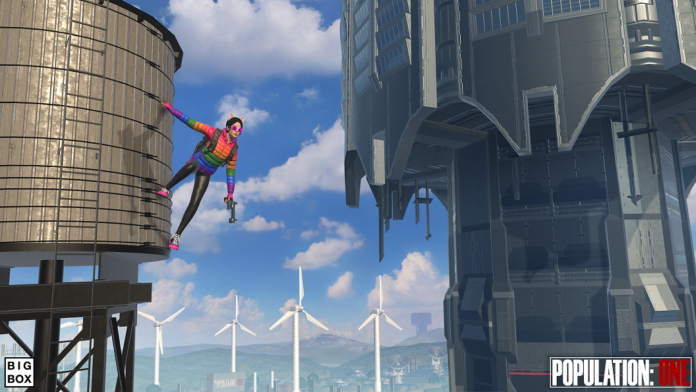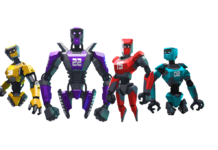Population: One, the battle royale experience VR enthusiasts have been waiting for, will release on all major VR platforms on October 22. A fantastic combination of climbing, building, and flying that would be impossible outside the realm of immersive reality, players can scale giant structures and then glide across a map while they zero in on enemies and coordinate with teammates for the best tactical advantages.
We’ve been hearing about Population: One since 2018, when the game entered private beta and also raised over $6 million in seed funding. During Facebook Connect last month, the imminent release of Population: One was hinted at when a new launch trailer debuted at the conference. There’s also an image of the game on the box of the new Oculus Quest 2, which is scheduled to launch on October 13.
Population: One comes to us from BigBox VR, a development studio committed to creating VR content that will help define the genre and contribute to the thriving VR esports ecosystem that has been growing rapidly since 2017. Based in Seattle and founded by industry entrepreneurs Chia Chin Lee and Gabe Brown, BigBox VR has amassed a team of incredibly talented game developers. The studio’s first VR game was Smashbox Arena, an action-based cartoon-style shooter released in 2016 that has achieved overwhelming success in homes and arcades. SmashBox Arena Leagues have popped up worldwide through organizers such as Ctrl V and the League of International VR Esports (LIVE).
As with Smashbox Arena, when they were developing Population: One, BigBox VR wanted to emphasize content only possible in virtual reality so early on one of the things they focused on was player comfort. The goal was to give players the ability to move freely and do things in the game that aren’t possible in physical reality, yet in such a way that it wouldn’t induce motion sickness. The Vertical Combat System (VCS) in Population: One does just that, enabling players with the ability to climb anything in the game: towers, road signs, trees, satellite dishes, gargoyles, etc. without getting nauseous. Yes, there are a few gargoyles. You can find those in the cemetery.
In addition to climbing structures with ease, although it might wear out your arms a bit, players have the ability to move across the map by jumping off the structures they climb and then gliding with outstretched arms. It’s also possible to use your weapons so if you see enemies you can shoot them while you’re still in the air. This definitely provides you with a satisfying 007 sort of sensation if you manage to take out an opponent while gliding. It’s also quite pleasing to snipe an enemy from the air and watch them fall to the ground, where you’ll discover their stash of guns, grenades, and ammo.
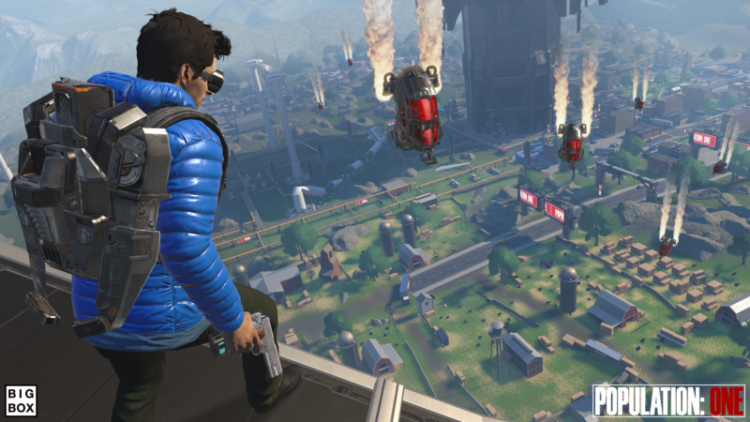
Immersive Reality
Many playtesters have compared Population: One to Fortnite, the sandbox shooter from Epic Games that has over 250 million registered players and made over $2.4 billion in 2018, according to Nielson’s SuperData tracking arm.
One key difference between Population: One and traditional battle royale games like Fortnite or CS:GO – or any traditional games for that matter – is the fact that Population: One gives you something those games can’t. It’s immersive. When you put on a VR headset, it feels like you’re actually IN THE GAME and this is an experience that is unparalleled in flat games.
The Town
Run by the “Game Bureau,” the town in Population: One has issues. Honestly I’m still not sure what those issues are or why we’re all shooting each other, but it really doesn’t matter at this point. It’s certain that the story will come out over time. For now the goal is simply to protect yourself and your squad mates.
Since the Game Bureau (GB) was responsible for the construction of major structures in the game such as the Tower, many players choose to begin looting on the outskirts of the map in areas like Cliffside, Farmlands, or Foothills. They think the GB can’t find them there, but of course they still can. Some brave souls jump straight into the middle of the action and fight for their lives in homes or industrial buildings downtown.
There are many great areas of the map, but my favorite place to get weapons is the Armory. I like to think of this as a stronghold of the resistance because I don’t think these guys like the Game Bureau. That’s probably why the Red Wall of Death frequently eats that area of the map first. (This might not be true, but it feels like it is.)
Another favorite map location is the Cemetery, mentioned earlier. Weapons are plentiful and it’s fun to climb around the different mausoleums or above-ground burial chambers. You can also stop to say a quick prayer in the cathedral or smash all the stained-glass windows. Honestly I rarely kill anyone in the Cemetery, but it’s a lot of fun to hang out there until the shrinking zone forces you to move on.
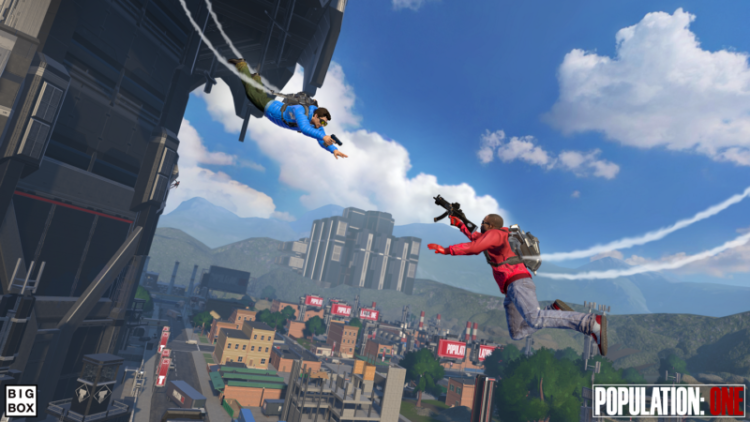
Favorite Features
There are many things about Population: One that make it appealing to fans of battle royale games, traditional first-person shooters, and virtual reality in general. Here are a few of my favorites.
Launch Ship: When a match begins, initially you’re put onto a map where players can say hello to one another or run around the streets while the game gathers all the players for that round. It takes only a minute or two for the round to be filled and then you’re placed on the launch ship. From this ship, you can take a pod and fly across the map until your pod runs out of gas or you can simply jump off and glide into the town. It’s so much fun to jump because it makes you feel free and it’s a peaceful sort of feeling to be in the air. You must be sure to glide, though, and not simply jump because you’ll fall to the ground and take heavy damage. Your fate is pretty much going to be a quick death if you fall to the ground without gliding.
Defibrillators: If you’re killed, your ghost body can meet up with teammates to be revived. It’s stressful, yet incredibly exciting when you’re in a tight spot with enemies all around and you’re trying to hide in a corner out of sight while charging your defibrillator paddles so you can revive your dead teammate. You can save them and be the hero! It’s important to give them one of your guns and some ammo, though, or they’re likely to be killed again pretty quickly.
Supply Drops: Unlike some battle royale games, in Population: One it’s actually possible to find weapons and ammo. They’re placed all around the map and I love this because it’s like Christmas every time you play the game and you discover which guns you’ll be able to use in this particular match. It gets even better, though, when you see a supply ship coming because that means there will be a supply drop so you can either try to gather special guns at the drop or ambush other players who are trying to do that.
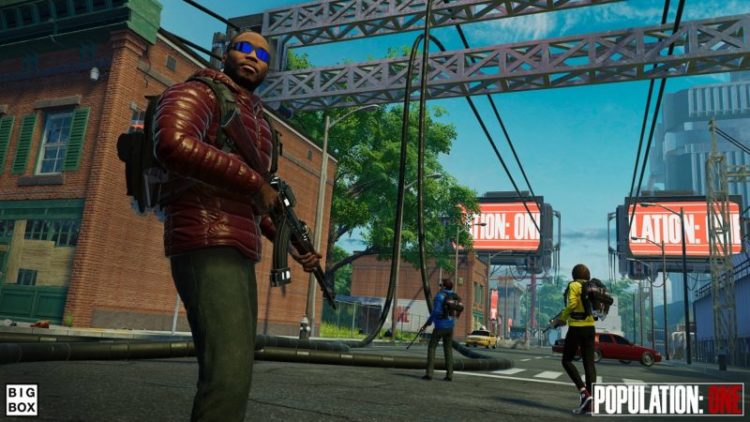
Building
Another commonality with battle royale predecessors like Fortnite and PlayerUnknown’s Battlegrounds (PUBG) is the ability to build in Population: One. It’s not essential to achieve victory, but here are some of the most common ways players have already begun to use building resources during the Population: One beta.
Building for Cover
Similar to traditional gaming counterparts, players in Population: One can develop the skill to build rapidly, which enables them to create structures that can provide cover from enemy fire. This is one of the best uses of the building supplies, especially under pressure.
Strategic Building
If you’re not particularly quick with building skills, you can always focus on strategic building. One of the best examples of this is for players who prefer the role of sniper.
I actually prefer sniper rifles in Population: One and one of my favorite guns is the AWP, a large sniper gun that has been used in games such as PUBG and Counter-Strike. It’s a bit large and not something you’d want to run around with shooting one-handed, but it’s so satisfying to zoom in on someone from across the map, hear that loud BOOM! and then see the tiny damage indicator pop up at the enemy’s location.
Definitely In a recent playtest, I was able to climb the large tower in the center of the map, build a structure on the side of the building, and then hang out there sniping enemy players until the Red Wall of Death closed in on me.
Building for Movement
Another use of the building materials in Population: One is that you can build structures that allow you to travel across an area quickly without having to run along the ground or glide. This is especially useful in open areas such as the Plains, where many people die.
With that movement advantage also comes the ability to build the structure and then glide to other areas, enabling you to choose how you make your way around the map.
One key difference between Population: One and games like Fortnite is that there are no ramps in Pop One. Playtesters have pointed this out frequently and say they love the fact that you have to lay walls horizontally or stand them vertically. This enables you to create more of a stair-like structure, but not ramps.
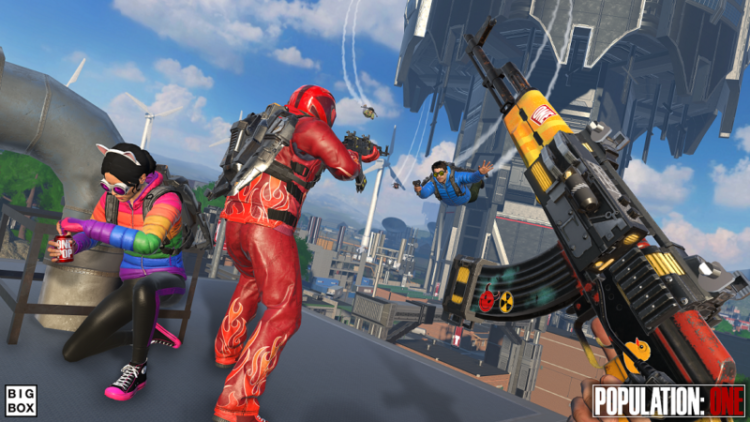
VR Esports
Most of you who are familiar with my history in VR esports might already be aware of my infatuation with Ready At Dawn’s Echo Arena, an amazing game that literally set the bar for what VR games should be. When Echo Arena went into open beta on the Oculus Quest in May, the game’s population exploded and I expect the same thing is going to happen with Population: One and the Quest 2. Already there are over 4,000 playtesters in the Discord and most of those have joined in the past two weeks. VR enthusiasts who enjoy the freedom of movement in VR and the thrill of first-person shooters are going to love the game.
Currently the tools aren’t in place to take Population: One into the full VR esports scene, but it will only be a matter of time.
Community
BigBox VR has been actively engaging with the Population: One community since 2018 when the first early beta testers were invited to a private Discord and to try out the game. The developers have listened to feedback, participated in playtests with the community, and fostered a positive environment.
You can become involved when you join other community members on social media.
- Join the subreddit.
- Join the Discord server.
- Follow Population: One on Twitter.
Conclusion
Population: One sets an incredibly high bar for battle royale games – not just in VR, but across the gaming ecosystem. I suspect fans of traditional battle royale games will be drawn to the experience out of curiosity for virtual reality, but I wager that they’ll fall in love with Population: One because they’ll be able to enjoy a fantastic battle royale experience immersed in the game.
Population: One is also going to raise the bar for other VR games. BigBox VR co-founders Chia Chin Lee and Gabe Brown had already established themselves as successful gaming industry entrepreneurs and now they’ve worked with their team to create another fantastic game while simultaneously encouraging the growth of a positive community that can exist beyond the virtual world.
BigBox VR’s Population: One comes to the Oculus Quest and Rift platforms, HTC Vive, Windows MR, and Valve Index on October 22 for $29.99. Stay tuned to VR Fitness Insider for more information about gameplay, fitness options, and VR esports news related to Population: One.

